Final Day Before Stage Two of Mini Transat
Published on October 30th, 2015
Lanzarote, Canary Islands (October 30, 2015) – A few hours before the Mini Transat – Îles de Guadeloupe start of the second leg, the pressure is mounting on the pontoons of Lanzarote. Each in their own way, the sailors are looking to dispel the inevitable stress that arises when it comes to crossing the Atlantic. Even if the weather conditions are optimal, they all know that no one is safe from a technical problem, that the crossing is long and that they will have to avoid both hard and soft blows.
It is frenzy around the Race PC of the Mini Transat îles de Guadeloupe. Hunched over the weather files, the racers are tired of running routing simulations, building castles in the air with the advice from the “guru routers”, or to attempt to glean more or less confidential information. Trying to introduce some rationality is a great way to exorcise their fears and doubts. Sometimes some of them let go, not accustomed to the waiting. It is the perfect time to refocus on very basic tasks and doing physical exercise to forget about obsessive thinking. Obviously, not everyone is in the same boat: for some zenitude is an art that has to be worked at, for others it is a more or less acquired predisposition.
Before the start from Douarnenez, the pressure was inevitably considerable for many racers: at the start of the race, almost all the racers were surrounded by their friends, relatives, partners for the luckiest ones. For all the rookies of the Atlantic, the first leg was a real leap into the unknown. The situation has changed slightly for the start from Lanzarote: they have all now experienced the first leg, the break of a few weeks allowed a number of racers to take a step back and enquiries from relatives and friends are less absorbing. Still, crossing the Atlantic is never trivial: without excessive pressure, staying focused is key.
There will be only 63 racers at the start of the second leg: the Estonian Jaanus Tame has had to renounce being at the start for personal reasons.
The trade wind for the first week
25-30 knots, sometimes more by Venturi effect between the islands, the beginning of the race promises to be exciting. Downwind, conditions are perfectly manageable, but should favour the most audacious racers, who are able find the right balance between how far their boats can be pushed and the no-go area. The exercise will be even more delicate as the Minis will leave with a slight overweight: an average of 25-30 kg of food, plus some 80 to 120 litres of water depending on the skipper. Water management is a kind of hymn to good sense: some parameters must be taken into account, such as the expected crossing time, daily requirements and the necessary reserve in case of breakage. At the start from Lanzarote, the Minis will have seen an average weight increase of 15%: with stresses on the rigging, rudders are especially significant and there is a real risk of breakage if the boat is overloaded at the start.
Given the weather situation, some are talking about a record time for the great crossing. But it is always difficult to make assumptions when the weather reports are for up to ten days. One near certainty, the high from the Azores should collapse in a few days and the trade wind should drop, at least along the great circle. The competitors will have to head south – but how far south? They will have to be clever, and interpret the wind changes and cloud cover, monitor the barometer. The racer best able to interpret all these signs stands a big chance of being the first to arrive in Pointe-à-Pitre.
IMPORTANT:
The skippers of the Mini Transat îles de Guadeloupe will gain an hour of sleep tomorrow morning. Indeed, the start of the second leg, originally planned at 1pm is deferred by one hour. The weather conditions and port movements justify this decision.
A ferry movement at 11am (local time) at the time the Minis were going out to join the start zone has forced the event organisers to change the start time. On this occasion, the race director has preferred to delay the crews getting moving, allowing a cold front expected at the end of the morning to dispel in the area.
Furthermore, the fleet will have to leave the island of Fuerteventura to starboard when leaving Lanzarote. Sustained weather conditions for the first night after the start have led the race direction to propose this change of course that limits passage between the islands and the potential venturi effects that can be particularly brutal, especially at night.
They have said:
Renaud Mary, President of the Mini Class: “We remain in the usual quotas: almost 80% of participants in the race are amateurs for almost 20% of neo-professionals. What struck me is that many racers exchanged information amongst themselves. I think for many it was necessary to dispel the apprehension born of the last edition. Given the perfect conditions that the competitors have had so far and that they may find in the second leg also, I have no doubt that we will have high good numbers again in 2017.”
Picture-perfect: the Guadeloupe islands
Bathed by the trade winds, the Guadeloupe Islands are a paradise for sailing, when one has to endure the harshness of winter in the city. Besides Gosier Marina, the starting point for many charter bases, the islands offer an unexpected change of scenery with the still unspoilt islands of Marie-Galante, Désirade or the Les Saintes archipelago. Guadeloupe also has an active maritime tradition that continues during the regattas of the Saintoises, the traditional boats that regularly compete in fierce racing. Several Guadeloupean skippers have taken part in the Mini Transat, from Victor Jean-Noël to François Lamy, the Thélier brothers and Luc Coquelin. The participation of Carl Chipotel continues this tradition. No doubt his arrival will be celebrated in style on the other side of the Atlantic.
Key Figures
The Race
72 boats
26 protos
46 series
7 support boats
The Skippers
68 men
4 women
52 rookies
20 return competitors
33 years average age
The youngest: 22 years old (Julien Hereu and Quentin Vlamynck)
The oldest: 56 years old (Carlos Lizancos)
15 nationalities
The Course
4021nm, 2 stopovers, 3 towns
Douarnenez – Lanzarote 1257nm
Lanzarote – Pointe-à-Pitre 2764nm
Key Dates
7th October 2015 – Prize Giving 1st Stage in Lanzarote
24th October 2015 – Prologue and Prize Giving (Lanzarote)
31st October 2015 – Start 2nd Stage: Lanzarote – Point-à-Pitre (Guadeloupe)
14th November 2015 – Estimated arrival time for the first boat at Point-à-Pitre
Race website – Race program – Tracker
Report by race media.
Background: For the 20th edition and for the second time, the Mini Transat – Îles de Guadeloupe returns to its origins with a start from Douarnenez (France). The Breton harbour had a fleet of 72 solo sailors set off on September 19 to Lanzarote (Canary Islands), where the Mini 6.50 will complete stage one of the race. The second stage will start on October 31, taking the fleet across the Atlantic to finish some three weeks later in Pointe-à-Pitre (Guadeloupe).


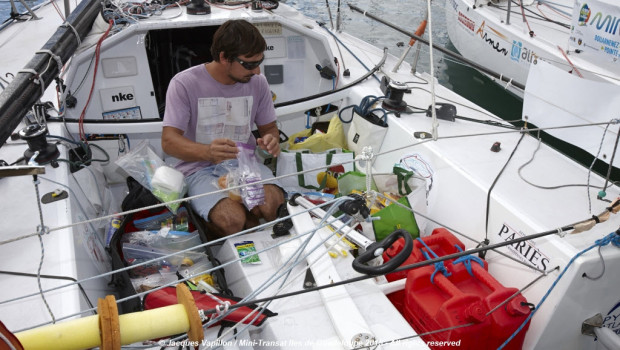

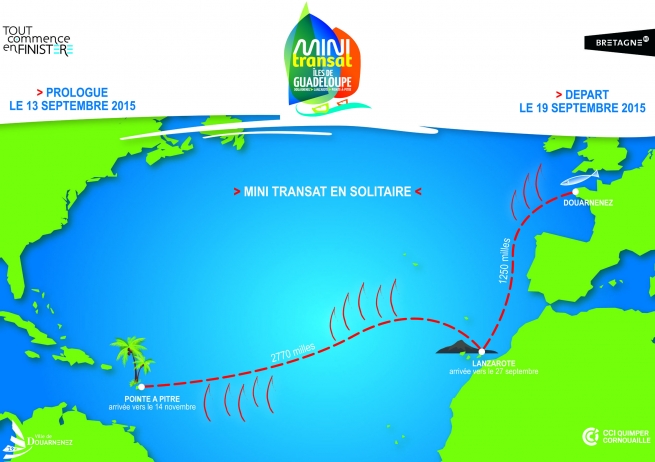


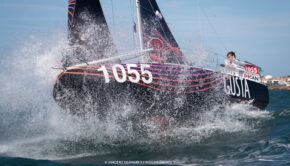
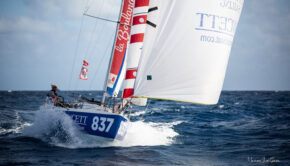
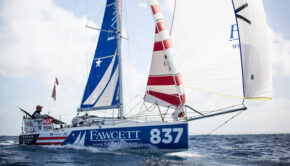
 We’ll keep your information safe.
We’ll keep your information safe.